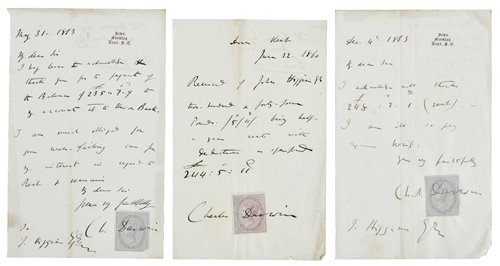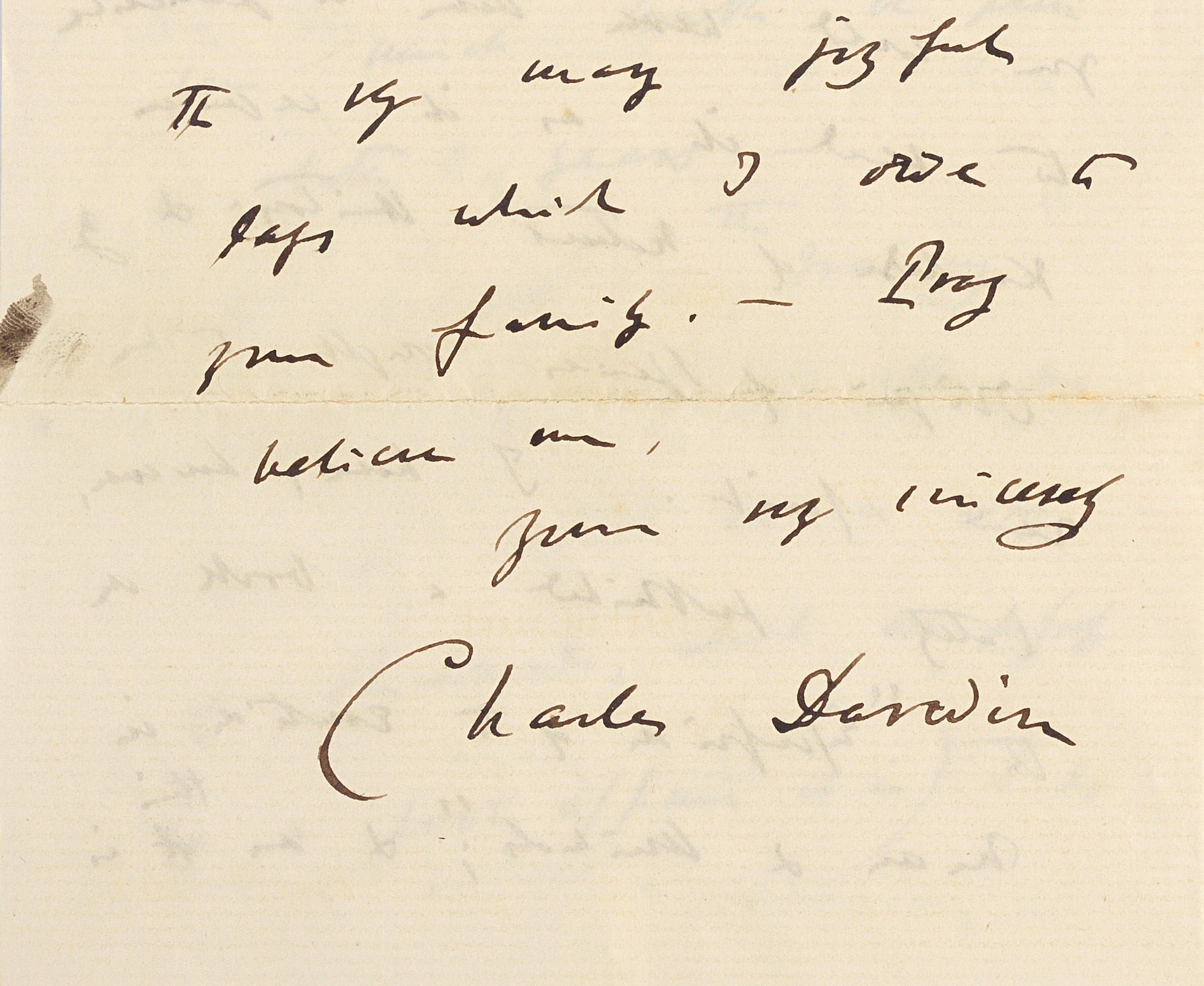DARWIN (CHARLES)Three fragments of greenstone from the summit of Cape Horn collected by Captain Robert FitzRoy on 19 April 1830 during the first voyage of the Beagle, with explanatory label, 50 x 50mm. and smaller; accompanied by an autograph letter from Charles Darwin's sister signed "E. Catherine Darwin", to Archdeacon Butler of Shrewsbury School ("Dear Sir"), presenting him with the fragments ("...Capt Fitzroy in the Expedition between 1826 to 30 ascended Cape Horn, and broke off a fragment of stone from the point; Charles has procured a bit from him to send to you. Charles had no means of referring to find the exact date of the Ascent. Capt. Fitzroy is the [onl]y person who ever has been on the [s]ummit..."), remains of address panel on reverse ("Rev/ Archdeacon Butler"), one page, professionally restored and mounted, old tape on reverse, 4to (225 x 190mm.), [n.p.], "Thursday Morning" [n.d.]Footnotes'CHARLES HAS PROCURED A BIT FROM HIM TO SEND TO YOU': FRAGMENTS OF STONE FROM CAPE HORN GATHERED ON THE FIRST VOYAGE OF THE BEAGLE, PRESENTED BY CHARLES DARWIN TO HIS OLD HEADMASTER.
Robert FitzRoy (1805-1865) describes his ascent of the summit on 19 April 1830 and the gathering of these samples thus: '... I afterwards went in a boat to Horn Island, to ascertain the nature of the landing, and whether it was practicable to carry any instruments to the summit of the Cape... At daybreak we commended our walk across the island, each carrying his load... Soon afterwards we reached the highest point of the Cape, and immediately began our work... We drank the health of His Majesty King George the Fourth, and gave three hearty cheers, standing round the Union Jack. Directly all was finished we travelled towards our boat as fast as possible... All reached the boat before nine o'clock, without losing or injuring any thing; but the cargo of stones, for specimens, which each brought back, delayed our returning progress materially. At daylight on the 21st we launched and stowed our boat, and set out on our return. We reached the Beagle that afternoon, well laden with fragments of Cape Horn...' (FitzRoy, R., Parker-King, P., Narrative of the Surveying Voyages of the 'Adventure' and 'Beagle' 1826-1836, 1839).
The so-called 'first' voyage of the Beagle is the voyage that made Robert FitzRoy's reputation as a surveyor and commander. In 1828 the Beagle and Adventure were engaged in a hydrographic survey of Tierra del Fuego and the South American coast. Robert FitzRoy then serving on the Ganges also in the area, was brought in as temporary captain of the Beagle after the suicide of the ship's commander Captain Pringle Stokes in December. It was on this voyage that FitzRoy, according to the letter from Darwin's sister included in the lot, procured these samples of greenstone from Cape Horn, notorious for its storms and treacherous seas.
FitzRoy had regretted not having a geologist aboard on his first voyage '...since as he suspected that there might be valuable minerals in the local rocks...' (Bowlby, John, Charles Darwin, A New Life, 1990, p.120). On his second voyage to the region, again in the Beagle, and undertaken from 1831 to 1836, FitzRoy was therefore accompanied by the young Charles Darwin in the dual role of Captain's companion and naturalist, and with whom he shared a particular interest in geology. Indeed, before they left England, FitzRoy gave Darwin a copy of Charles Lyell's recently published Principles of Geology and had been charged by Lyell to record observations on geological features in the area. It is therefore highly conceivable that FitzRoy would have presented Darwin with these samples from his collection that he had gleaned on his earlier voyage. What was supposed to be a two-year voyage lengthened into five and those long years in close proximity engendered a mutual respect and admiration between the two men, despite FitzRoy's bouts of temper and depression, but back in England, their differing views on politics, religion and matters of evolutionary theory caused an irreconcilable rift.
The recipient of the samples was Darwin's erstwhile headmaster at Shrewsbury School, Samuel Butler (1774-1839), classicist and bishop of Coventry and Lichfield, who held the position of headmaster for 37 years from 1798. Darwin was disparaging about his schooldays, the classical curriculum espoused by Dr Butler forcing him to pursue his interest in natural history in the school holidays: 'The school as a means of education to me was simply a blank', he wrote, 'I was considered by all my masters and by my father as a very ordinary boy' (Bowlby, p.63). However, the close proximity of the Darwin family home, The Mount, to the school maintained Butler's connection with the family. A typed note of provenance with the lot confirms that the rock was '...obtained for the archdeacon by Charles Darwin to be placed in a collection of rocks from all parts of the world, made by the archdeacon. The collection, in a cabinet, was given to A.M.L.B. by a descendant of Archdeacon Butler, in 1961 and this letter, together with the rock fragment was in the cabinet...'. The same note also dates Emily Catherine Darwin's letter to between 1838 and 1840.
The Australian Museum Research Institute has compared photographs of our samples with examples of Cape Horn diorite in their collection and have concluded that 'the rock colour and texture are a close match to your Cape Horn rock'. It would appear therefore that our samples are geologically consistent with rock found in that area.
Provenance: Vice-Admiral Robert FitzRoy (1805-1865); Charles Darwin (1809-1882); Archdeacon Samuel Butler (1774-1839); given to Alison Leadley-Brown by a descendant in 1961; thence by descent to the present owner.
DARWIN (CHARLES)Three fragments of greenstone from the summit of Cape Horn collected by Captain Robert FitzRoy on 19 April 1830 during the first voyage of the Beagle, with explanatory label, 50 x 50mm. and smaller; accompanied by an autograph letter from Charles Darwin's sister signed "E. Catherine Darwin", to Archdeacon Butler of Shrewsbury School ("Dear Sir"), presenting him with the fragments ("...Capt Fitzroy in the Expedition between 1826 to 30 ascended Cape Horn, and broke off a fragment of stone from the point; Charles has procured a bit from him to send to you. Charles had no means of referring to find the exact date of the Ascent. Capt. Fitzroy is the [onl]y person who ever has been on the [s]ummit..."), remains of address panel on reverse ("Rev/ Archdeacon Butler"), one page, professionally restored and mounted, old tape on reverse, 4to (225 x 190mm.), [n.p.], "Thursday Morning" [n.d.]Footnotes'CHARLES HAS PROCURED A BIT FROM HIM TO SEND TO YOU': FRAGMENTS OF STONE FROM CAPE HORN GATHERED ON THE FIRST VOYAGE OF THE BEAGLE, PRESENTED BY CHARLES DARWIN TO HIS OLD HEADMASTER.
Robert FitzRoy (1805-1865) describes his ascent of the summit on 19 April 1830 and the gathering of these samples thus: '... I afterwards went in a boat to Horn Island, to ascertain the nature of the landing, and whether it was practicable to carry any instruments to the summit of the Cape... At daybreak we commended our walk across the island, each carrying his load... Soon afterwards we reached the highest point of the Cape, and immediately began our work... We drank the health of His Majesty King George the Fourth, and gave three hearty cheers, standing round the Union Jack. Directly all was finished we travelled towards our boat as fast as possible... All reached the boat before nine o'clock, without losing or injuring any thing; but the cargo of stones, for specimens, which each brought back, delayed our returning progress materially. At daylight on the 21st we launched and stowed our boat, and set out on our return. We reached the Beagle that afternoon, well laden with fragments of Cape Horn...' (FitzRoy, R., Parker-King, P., Narrative of the Surveying Voyages of the 'Adventure' and 'Beagle' 1826-1836, 1839).
The so-called 'first' voyage of the Beagle is the voyage that made Robert FitzRoy's reputation as a surveyor and commander. In 1828 the Beagle and Adventure were engaged in a hydrographic survey of Tierra del Fuego and the South American coast. Robert FitzRoy then serving on the Ganges also in the area, was brought in as temporary captain of the Beagle after the suicide of the ship's commander Captain Pringle Stokes in December. It was on this voyage that FitzRoy, according to the letter from Darwin's sister included in the lot, procured these samples of greenstone from Cape Horn, notorious for its storms and treacherous seas.
FitzRoy had regretted not having a geologist aboard on his first voyage '...since as he suspected that there might be valuable minerals in the local rocks...' (Bowlby, John, Charles Darwin, A New Life, 1990, p.120). On his second voyage to the region, again in the Beagle, and undertaken from 1831 to 1836, FitzRoy was therefore accompanied by the young Charles Darwin in the dual role of Captain's companion and naturalist, and with whom he shared a particular interest in geology. Indeed, before they left England, FitzRoy gave Darwin a copy of Charles Lyell's recently published Principles of Geology and had been charged by Lyell to record observations on geological features in the area. It is therefore highly conceivable that FitzRoy would have presented Darwin with these samples from his collection that he had gleaned on his earlier voyage. What was supposed to be a two-year voyage lengthened into five and those long years in close proximity engendered a mutual respect and admiration between the two men, despite FitzRoy's bouts of temper and depression, but back in England, their differing views on politics, religion and matters of evolutionary theory caused an irreconcilable rift.
The recipient of the samples was Darwin's erstwhile headmaster at Shrewsbury School, Samuel Butler (1774-1839), classicist and bishop of Coventry and Lichfield, who held the position of headmaster for 37 years from 1798. Darwin was disparaging about his schooldays, the classical curriculum espoused by Dr Butler forcing him to pursue his interest in natural history in the school holidays: 'The school as a means of education to me was simply a blank', he wrote, 'I was considered by all my masters and by my father as a very ordinary boy' (Bowlby, p.63). However, the close proximity of the Darwin family home, The Mount, to the school maintained Butler's connection with the family. A typed note of provenance with the lot confirms that the rock was '...obtained for the archdeacon by Charles Darwin to be placed in a collection of rocks from all parts of the world, made by the archdeacon. The collection, in a cabinet, was given to A.M.L.B. by a descendant of Archdeacon Butler, in 1961 and this letter, together with the rock fragment was in the cabinet...'. The same note also dates Emily Catherine Darwin's letter to between 1838 and 1840.
The Australian Museum Research Institute has compared photographs of our samples with examples of Cape Horn diorite in their collection and have concluded that 'the rock colour and texture are a close match to your Cape Horn rock'. It would appear therefore that our samples are geologically consistent with rock found in that area.
Provenance: Vice-Admiral Robert FitzRoy (1805-1865); Charles Darwin (1809-1882); Archdeacon Samuel Butler (1774-1839); given to Alison Leadley-Brown by a descendant in 1961; thence by descent to the present owner.




.jpg)


.jpg)
.jpg?w=400)

.jpg?w=400)




Testen Sie LotSearch und seine Premium-Features 7 Tage - ohne Kosten!
Lassen Sie sich automatisch über neue Objekte in kommenden Auktionen benachrichtigen.
Suchauftrag anlegen